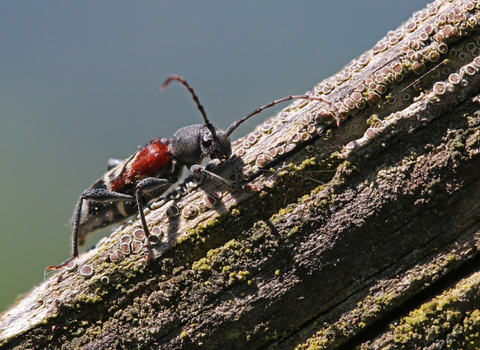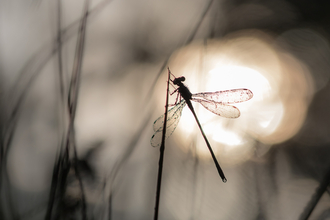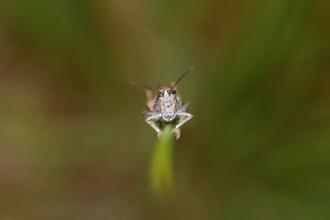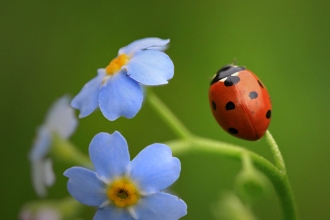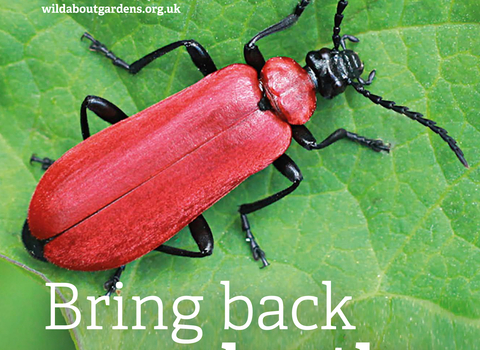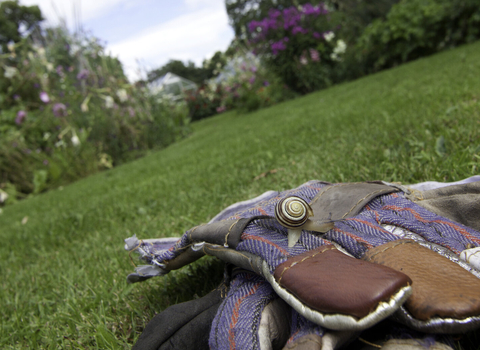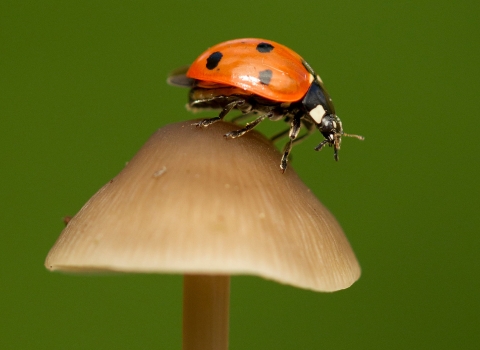With over 4000 species of beetle in the UK, the task of choosing just a few wasn’t easy but, with the help of local beetle fan Nick Button, we hope to offer a taste of the rich variety of beetles that can be found locally and that worldwide make up more than a quarter of the world’s animals.
What makes a beetle a beetle are the hardened wing cases (elytra), biting mouthparts and complete metamorphosis. They come in almost every shape and size imaginable varying from huge stag beetles to polished leaf beetles to inconspicuous rove beetles. They occupy almost every niche available and with the recent growth in excellent beetle websites and literature, there has never been a better time to explore and identify these fascinating creatures.
If you'd like to help this amazing group of animals, download your free Wild About Gardens - Bring back the beetles booklet.
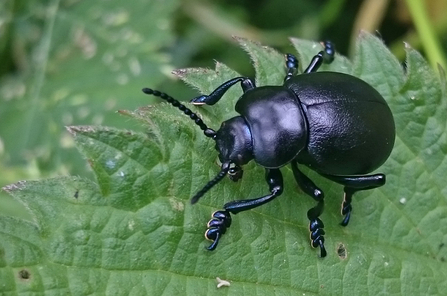
Bloody-nosed beetle by Wendy Carter
Bloody-nosed beetle Timarcha tenebricosa
This large, plodding leaf beetle (aka blood spewer) is known for its defensive behaviour of exuding acrid red droplets from its mouth to put off predators such as birds. A local species in Worcestershire, try looking at Hartlebury Common and other areas of heathland where you can find the host plant for the plump and similarly distinctive larvae, heath bedstraw.
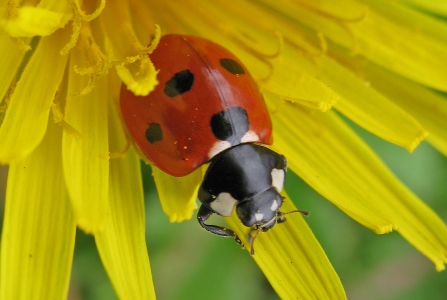
7 spot ladybird by Rachel Scopes
7-spot ladybird Coccinella septempunctata
7-spot ladybirds are one of our most recognisable minibeasts and are almost universally loved by children and adults alike. They're found in our gardens and parks and are in demand by gardeners who appreciate their ability to munch through aphids. Adults hibernate in hollow plant stems or tucked into nooks and crannies. There are similar-looking ladybirds but it's easy to identify this species by counting the spots - a large spot at the top of both wing cases and three spots on each wing case. We're keen to know where Worcestershire's ladybirds are so if you see one, take a picture and submit it via our short wildlife sightings form.
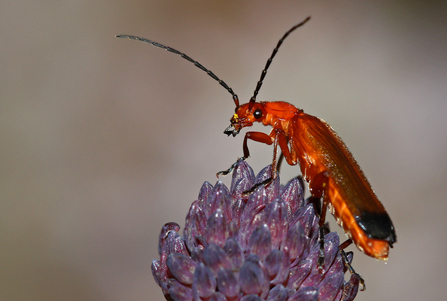
Common soldier beetle by Wendy Carter
Common red soldier beetle Rhagonycha fulva
One of about 40 species of soldier beetles in the UK, these are the most common and are spotted from June to August, often as they crowd onto the flower heads of umbels like hogweed. Keen gardeners would do well to encourage these striking creatures into their gardens as the adults feed on aphids (as well as pollen and nectar) and the larvae prey on ground-dwelling invertebrates such as slugs and snails. Look for their red-orange colouring with dark tips to their wing cases...and they're often found in pairs!
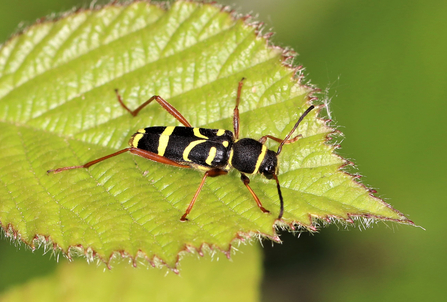
Wasp beetle by Nick Button
Wasp beetle Clyteus arietis
I probably have more photographs of this longhorn beetle than any other; never failing to admire this striking wasp mimic that not only looks like but also imitates a wasp’s jerky movement. They occasionally fly some distance and can be found in gardens but a good place to look is on vegetation along woodland rides during summer; time your visit for flowering hogweed and you’ll find these and many other interesting beetles.
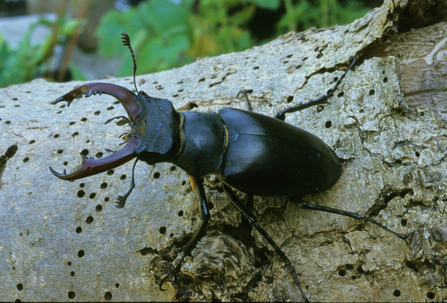
Stag beetle by Harry Green
Stag beetle (Lucanus cervus)
Male stag beetles, with their prominent 'antlers', are the UK's largest land-dwelling beetle and a sight to behold! They use the antlers to spar with other males for the attention of females. In Worcestershire, they're only known from Upton-upon-Severn and surrounding villages - look for them on warm days in June and July. The females don't have the antlers and are easily mistaken for lesser stag beetles but true stag beetles have a shiny black head and thorax with a chestnut hue to their wing cases.
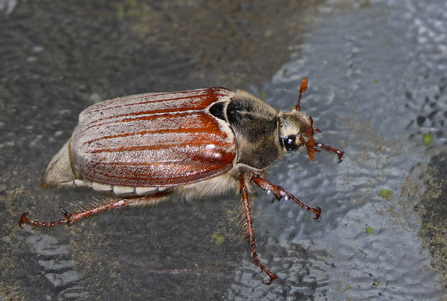
Cockchafer by Wendy Carter
Cockchafer Melolontha melolontha
Also known as May bugs, cockchafers are often known for crashing into windows as they follow the light on a late spring evening. Females can lay up to 80 eggs, which develop underground for up to three years as they feed on roots and tubers. Adults live for just six weeks and you can identify male from female by counting the 'leaves' on their fanned antennae - males have seven, females have six. These antennae are perfect for detecting pheromones - the chemical scents that allow individuals to find each other.
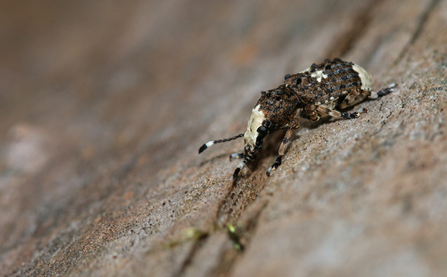
Platystomos albinus by Wendy Carter
Platystomos albinus
Having evolved to imitate a bird dropping, this smart fungus weevil typically spends its larval stage in broadleaved wood infected with the fungus King Alfred's cakes or cramp balls. They can be found throughout much of the year; adults are mostly active at night but it’s well worth looking for them on logs and other deadwood in the daytime.
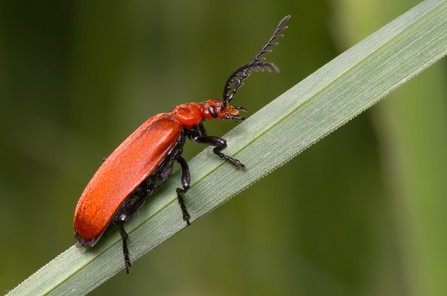
Red-headed cardinal beetle by George Hauxwell
Red-headed cardinal beetle Pyrochroa serraticornis
These striking red beetles are deadwood-lovers, laying their eggs under the bark of deadwood where the larvae can take several years to mature. Look out for these and their less common relatives, the black-headed cardinal beetles, sunbathing on leaves and flowers along woodland rides, in hedgerows and sometimes in gardens. Whilst they themselves are predators of smaller insects, their bright colouring warns potential predators that they're toxic and should be left alone.
Ant beetle by Nick Button
Ant beetle Thanasmius formicarius
A member of the family Cleridae (chequered beetles), this beetle pretends to carry a sting by mimicking the colour and pattern of velvet ants. They seek out trees inhabited by bark beetles to lay eggs; as adults they can be seen roaming tree trunks searching for prey. They are quite scarce in Worcestershire but a good place to search is on tree trunks and logs in woods; especially after dark when they become active.
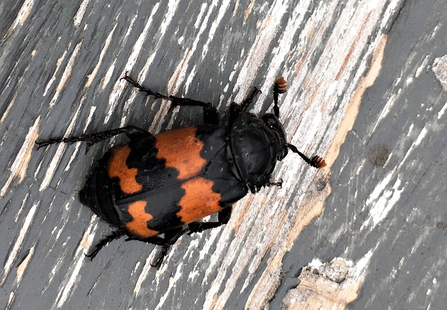
Banded sexton beetle by Nick Button
Banded sexton beetle Nicrophorus investigator
Also known as “burying beetles” this is one of several beetles that, with a strong sense of smell, locate the dead body of a small bird or mammal. They carefully conceal the animal by digging away the earth beneath or moving it a short distance. Astonishingly, the parents continue to tend the carcass and feed the larvae throughout their lives. Banded sexton beetles are quite common and readily come to sources of light at night.
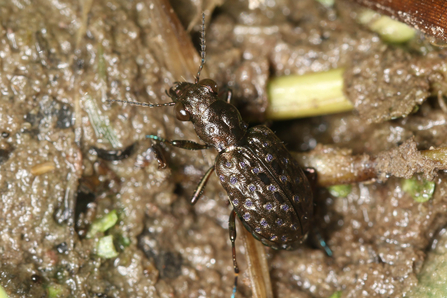
Copper peacock by Neil Harris
Copper peacock Elaphrus cupreus
The majority of ground beetles (Carabidae) are dark and uniform in colour but this striking metallic jewel of a beetle is decorated with a series of violet/blue pits that together reflect light in a way to provide the cryptic camouflage that allows them to hunt in sparsely vegetated wetland habitats. They have large eyes, move quickly and are widespread and fairly frequent throughout Worcestershire.
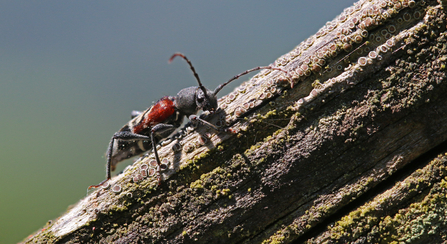
Anaglyptus mysticus by Wendy Carter
Anaglyptus mysticus
Look for these striking beetles in woodlands, hedgerows and other places where deadwood is found - their larvae feed for two to three years in dead and decaying broadleaf trees. The adults emerge in April, having spent winter under the bark of the tree in a pupal cell, and can be found until July. They feed on flowers - check hawthorn and umbellifers in particular. They are widespread across Worcestershire but not often seen.
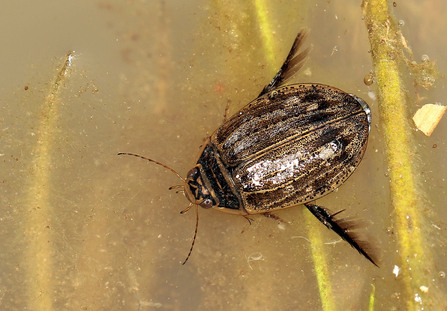
Lesser diving beetle by Nick Button
Lesser diving beetle Acilius sulcatus
At about 17mm and roughly half the size of the formidable great diving beetle these beetles can be seen paddling in all types of still and slow-moving water bodies from lakes to cattle troughs. They are fairly common and conspicuous as they row jerkily near the water surface, occasionally upending and exposing the rear of the abdomen for a breather. They are formidable predators, strong flyers and will come to light.
Onthophagus coenobita by Nick Button
Onthophagus coenobita
Dung beetles are the farmer’s friend, breaking down and recycling nutrients and helping to maintain a healthy soil that results in increased grass growth (for free) as well as providing an essential food source for wildlife such as birds and bats. Look in or around horse or cow dung where they excavate a burrow in which to deposit a column of dung balls, each with a single egg.
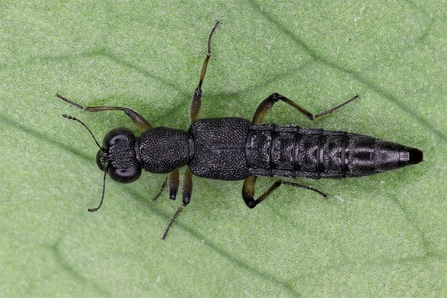
Stenus clavicornis by Nick Button
Stenus clavicornis
Stenus belong to the extensive rove beetle family (Staphylinidae); typically narrow and sinuous beetles with short wing cases. A great deal (like this one) are tiny but these are distinctive with bulging eyes that create a hammer-like head. They have an extraordinary chameleon-like behaviour of capturing prey by rapidly extending their long and sticky lower lip. Many are associated with marginal wetland habitats where, as a means of escape, the release of chemical compounds can propel them across water.

